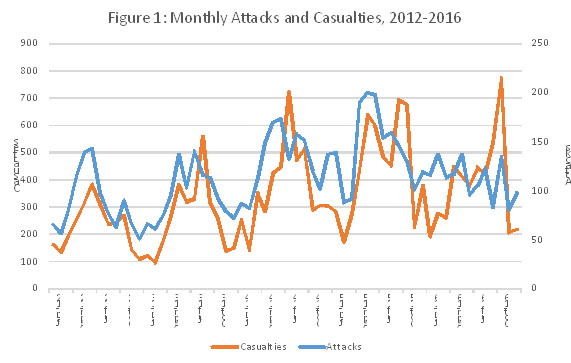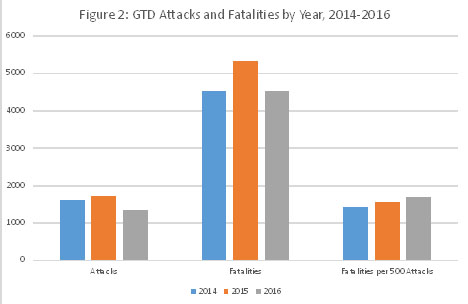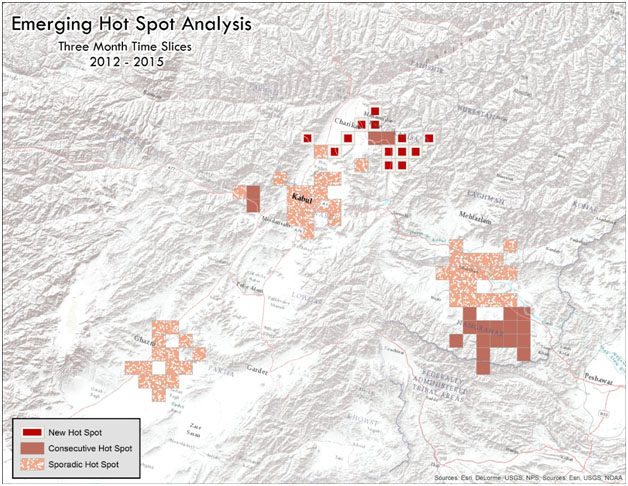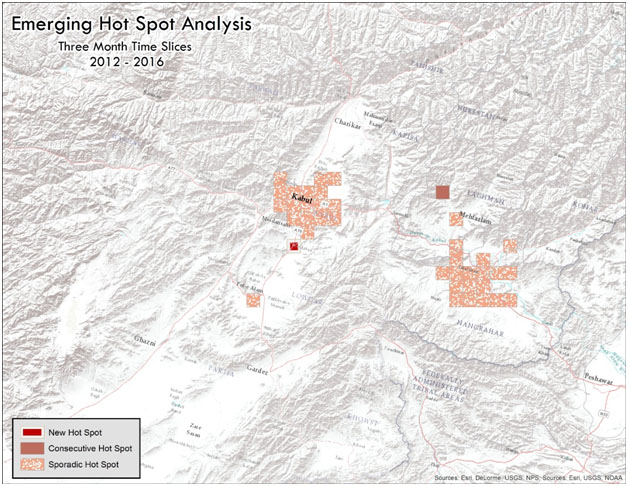The End of Afghanistan’s Spring Fighting Seasons and the Demise of the Afghan National Security Forces?[i]
Barnett S. Koven
While many rejoice the arrival of spring, Afghans know that this season ushers in a considerable increase in fighting. Or at least it used to. A confluence of three factors – the conclusion of poppy cultivation, improved weather conditions and recesses in madrassas in neighboring Pakistan – have made spring Afghanistan’s ‘fighting season.’ However, 2016 marked the first year, since insurgent violence first surged in 2006, where the arrival of spring did not correlate with an increase in insurgent attacks. Indeed, attacks trended downward as the season progressed. Moreover, insurgent violence fell precipitously compared to 2015 (1,338 attacks in 2016 versus 1,716 incidents in 2015; a decrease of 22 percent). Figure 1, below, depicts this trend, as well as casualty rates, using data from 2012 through 2016. Paradoxically, this is cause for serious concern. While one might think that the end to Afghanistan’s fighting season and a considerable decline in attacks is a positive development, ‘the logic of violence in civil war’ is far more nuanced. Specifically, violence decreases as a belligerent cements control over territory. In this case, decreasing violence appears to be the result of increasing Taliban control and the rapid deterioration of the Afghan National Security Forces (ANSF).

This article proceeds in four sections. The first explains the aforementioned factors that contributed to the seasonality of fighting in Afghanistan. The subsequent section summarizes the extant literature, which explains trends in insurgent violence. The penultimate section analyzes the latest data from the Global Terrorism Data (GTD) and other sources, with specific reference to the theories explained in the previous section. The final section concludes.
Seasonality and Conflict in Afghanistan
As previously noted, Afghanistan’s spring surge in violence corresponds to agricultural cycles, improved weather and breaks in instruction at Pakistani madrassas. This section explores the relationship between each of these three factors and springtime fighting.
Arguably, agricultural cycles have the greatest impact on defining the Afghan fighting season. This is the case for two reasons. First, the Taliban rely on the cultivation and trafficking of opium poppy to finance their insurgency. As such, fighting occurs around opium poppy cultivation cycles. Specifically, the United Nations Office on Drugs and Crime (UNODC) reports that opium cultivation has surged from a low of just 8,000 hectares under cultivation in 2001 to a high of 224,000 hectares in 2014, before tapering off slightly in 2015. The farm-gate value of the crop peaked earlier, in 2011, at over $1.4 billion. While the farm-gate value decreased to $572 million in 2015, significant value is added through subsequent refinement and trafficking. The Taliban are heavily involved in these activities as well.
Beyond the Taliban’s financial interest in opium poppy production, the harvest season robs the Afghan Taliban of much of their fighting force. One Afghan expert noted that three distinct classes of Taliban fighters exist. Specifically, he indicated that the ‘ideological Taliban,’ which as the name implies are those insurgents who are deeply ideologically committed, represent only a very small percentage of the groups fighting force. A second group that he termed the ‘mercenary Taliban’ constitute a relatively larger fraction of the Taliban’s overall force strength. This group is heavily involved in the opium economy and other illicit actives. It sides with the Taliban due to the opportunity to profit handsomely from opium cultivation and related activities and not because of ideology. By far the largest group of fighters, are the ‘paycheck Taliban,’ who are comprised of seasonal or otherwise under-employed or unemployed young men who take-up arms to earn a paycheck when they are not engaged in productive economic activity.[ii] In Afghanistan, where as much as 40 percent of the economy is agrarian, the bulk of these fighters are agricultural workers. In short, during harvest times, the number of available insurgent fighters is substantially lower.
Second, harsh weather makes winter fighting extremely challenging. Specifically, the confluence of extremely difficult terrain, limited improved road networks and substantial snowfall make overland travel next to impossible in parts of the country. For example, a particularly strong winter storm dumped more than five feet of snow in parts of the border region between Afghanistan and Pakistan during just a 24 hours period earlier this year. This particular storm left more than 100 Afghans dead. These types of weather dynamics are common place and some remote parts of Afghanistan remain completely cutoff from the rest of the country by inclement weather for as many as six months a year.
Finally, existing research on civil wars and insurgencies show that the presence of cross-border sanctuaries greatly exacerbates the duration of conflicts and the odds of an opposition victory. Not surprisingly, ample evidence from the conflict in Afghanistan highlights the criticality of secure basing in Pakistan to the success of the Afghan Taliban.[iii] Importantly, madrassas on the Pakistani side of the Afghanistan-Pakistan border, which provide a combination of religious education and military training, go on recess in the spring. Though this may be as much a consequence as a cause of the spring fighting season.
‘The Logic of Violence in Civil War’
As already noted, decreasing violence during insurgent conflicts can be cause for celebration or serious concern. This is the case as it may signal that the counterinsurgent is cementing control or that insurgent forces are gaining ground. In explicating this phenomena, Stathis Kalyvas classified areas within insurgent conflicts on a one to five scale based on territorial control. Areas under total incumbent control are coded a 1, areas under dominant incumbent control are denoted by a 2, contested areas are a 3, areas under dominant insurgent control are classified as a 4 and areas under complete insurgent control are marked as 5. As government forces gain (movement from zone 3 to 2) or consolidate (movement from zone 2 to 1) control, we would expect to see an increase in fighting. Similarly, as insurgent forces gain (a movement from zone 3 to 4) or consolidate (movement from zone 4 to 5) control, violent attacks are also likely to increase. In the former scenario an increase in violence is positive. The opposite is the case in the latter. However, Kalyvas not only shows that there is a correlation between changing zones of control and levels of violence, he also demonstrates that the type of violence depends on the zone of control. Specifically, in zone 3, civilian populations are unlikely to provide intelligence to either side because neither belligerent is dominant and doing so risks repercussions from the other side. Absent extensive human intelligence sources, both sides will be forced to rely more heavily on indiscriminant violence. As one side gains control (a move from zone 3 to either zone 2 or 4), risks decrease for civilians providing intelligence to the dominant side. As such, the belligerent that has gained control will be able to perpetrate violence more selectively. Doing so is also desirable as it is less likely to alienate the population and more efficient.
Violent Attacks, Territorial Control and the End of the Afghan Spring Fighting Season
After just over 13 years in-country, the NATO-led International Security Assistance Force (ISAF) pulled out of Afghanistan on December 28, 2014. With the departure of ISAF, which at its heighted totaled more than 130,000 NATO and allied soldiers, the ANSF were left to continue fighting the Taliban largely on their own. (Even though 9,804 U.S. troops and a much smaller contingent from other NATO members remained behind, experts agree that not only is this an inadequate force-strength to prop up the ANSF, but the fact that the vast majority of these forces are relegated to train and equip missions and cannot be deployed in combat operations, further limits their impact.) Unfortunately, the ANSF forces are hampered by rampant corruption, inconsistent training across military units, difficulty retaining qualified personnel, as well as limited abilities to undertake complex operations involving combined arms integration. Corruption, in particular, deserves special attention. A January 2016 report noted that as much as 40 percent of the ANSF are ‘ghost’ soldiers and police officers. Specifically, these personnel – if they ever existed in the first place – have either been killed or deserted. Nevertheless, their commanders keep them on the books and pocket their pay and rations.
Under these conditions, and absent ISAF support, it is unsurprising that the Taliban surged in 2015. Specifically, the GTD notes that insurgent attacks increased from 1,594 in 2014 to 1,716 in 2015 (a nearly 8 percent increase). Moreover, the number of resulting fatalities climbed from 4,507 to 5,307 (an increase of almost 18 percent). One report notes that ANSF casualties in 2015 alone were double the number of insurgent casualties inflicted by U.S. forces in the preceding 13 years. Nevertheless, violence decreased markedly in 2016. Specifically, 2016 experienced only 1,338 attacks (a decrease of more than 22 percent from 2015 and over 16 percent from 2014).[iv] Figure 2, below, depicts these trends graphically.

Furthermore, an examination of Figure 1, above, shows that there is no evidence of the characteristic spring fighting season in 2016. Figures 3 and 4, below, display similar trends. Specifically, Figure 3 presents a snapshot of the results of emerging hot spot analysis conducted utilizing the GTD data[v] from 2012 to 2015, while Figure 4, examines the time period from 2012 to 2016. Each cube represents a five square mile grid. The analysis shows that sporadic hotspots, which entail a repeated pattern of fighting during certain three month time periods and not others, were relatively prevalent in the analysis ending in 2015 (Figure 3). However, once the analysis is extended through 2016, sporadic hot spots, and thus seasonality in fighting remain in just two areas, the capital, Kabul, and in Afghanistan’s second largest city and commercial hub, Jalalabad. These results are robust across analyses for the entire country. What explains this apparent reversal?
Figure 3: Emerging Hot Spot Analysis, 2012-2015

Figure 4: Emerging Hot Spot Analysis, 2012-2016

Unfortunately, it is likely the case that violence declined in 2016 because the Taliban had succeeded in retaking territory in 2015, which also explains the marked increase in violence during 2015. Indeed, within a year of ISAF’s withdrawal, the Taliban controlled more territory in Afghanistan than at any time since 2001.[vi] Following the logic of violence in civil wars, if enhanced territorial control explains the decrease in violence and the end of the spring fighting season, we would also expect to see a change in the nature of violence. Indeed, we do. Specifically, attacks became better targeted and more selective. As regards targeting, even though 2016 experienced 22 percent fewer attacks than 2015, the number of fatalities per attack increased by over nine percent (from an average of 3.09 fatalities per attack in 2015, to an average of 3.38 in 2016; see Figure 2, above, for a graphical representation of these data). Increasing lethality is likely a result of improved intelligence – due to the Taliban’s enhanced territorial control – enabling better targeting. In a similar vein, attacks became more selective. Specifically, ANSF casualties continued to rise in 2016. While civilian casualties also increased in 2016, they did so at a far lower rate. Moreover, the number of Taliban inflicted civilian casualties actually fell. The overall rise in civilian casualties is due to the emerging presence of the Islamic State (IS) in Afghanistan. While the IS had previously been a minor player in the country, in 2016 it caused more than an order of magnitude more civilian casualties than it had during the previous year.
Even though the Taliban do not control all of Afghanistan, the ANSF have often proven unable to sustain fighting with the Taliban when they threaten new areas. As such, further territorial expansion by the Taliban may not require as many attacks as it had previously. For example, in March 2017, the Taliban retook the strategic town of Sangin in Helmand province after the ANSF withdrew, ostensibly to avoid civilian casualties. However, the Taliban’s claim to have captured 39 armored personnel carriers, one tank and 34 other vehicles that the ANSF left behind, suggests a hasty retreat. Sangin is a critical location for Taliban opium smuggling operations. Again, the emerging hot spot analysis is consistent with this explanation. Despite the fact that the Taliban continued to capture territory in 2016, there are virtually no new hot spots evident in Figure 4, above. This indicates that fighting is not breaking out, even when the Taliban moves into new territories and ANSF withdraws. This is in stark contrast to the Taliban’s 2015 territorial expansion efforts, which resulted in extensive fighting, as illustrated in Figure 3, also above. (There are virtually no more consecutive hot spots evident in Figure 4, which indicates that sustained fighting is also no longer occurring. Again, this finding sharply contrasts with patterns evident prior to 2016, depicted in Figure 3.)
Conclusion
In short, the apparent decline in violence and the end of seasonality in fighting in 2016 appear to indicate that the Taliban has made substantial inroads against the ANSF. Furthermore, even though the number of attacks has declined, casualties are up as each attack is now more effective. Moreover, the ANSF are increasingly being targeted by attacks. This is likely the case as increased territorial control affords the Taliban better intelligence. Nevertheless, it is unclear what 2017 has in store for Afghanistan. On the one hand, it is possible that violence will continue to decline as the ANSF forces are further weakened and the Taliban continue to expand their territorial control. Indeed, as of late 2016, the Taliban had already encircled six provincial capitals. On the other hand, it is possible that violence will rise and seasonality will again define the fighting as the IS begins to present a greater challenge to the Taliban. The deployment of additional Western troops, which is now being considered following a massive explosion in the, supposedly highly secure, diplomatic area of Kabul that killed 80 during rush hour on May 31, 2017, could also have similar effects. (Importantly, the Taliban, who are often quick to take credit for their exploits, have already denied responsibility for the bombing.) However, this will depend on the number of additional troops, restrictions on their employment and the length of time additional troops will remain in-theater.
End Notes
[i] I wish to thank Erin Miller for providing access to the 2016 Global Terrorism Database (GTD) data ahead of its public release, as well as for her constructive comments. In addition, special thanks is due to Marcus A. Boyd, for conducting the emerging hotspot analysis presented herein. Nevertheless, all errors are my own.
[ii] Ahmad, Javid, in discussion with Barnett S. Koven, April 8, 2014.
[iii] See also: Rashid, Ahmed, “Letter from Afghanistan: Are the Taliban Winning?,” Current History 106, no. 696 (January 2007): 17-20.; Tellis, Ashley J., “Pakistan's Record on Terrorism: Conflicted Goals, Compromised Performance,” The Washington Quarterly 31, no. 2 (2008): 7-32.
[iv] See also: Burns, Robert, “Decrease in Taliban violence leaves US officials cautiously hopeful.” The Christian Science Monitor (July 18, 2016). http://www.csmonitor.com/USA/Military/2016/0718/Decrease-in-Taliban-violence-leaves-US-officials-cautiously-hopeful.
[v] Observations that were only georeferenced at the national or regional level were excluded from the emerging hot spot analysis to improve specificity.
[vi] See also: Roggio, Bill, “Afghan Taliban lists ‘Percent of Country under the control of Mujahideen,’” Long War Journal (March 28, 2017).

